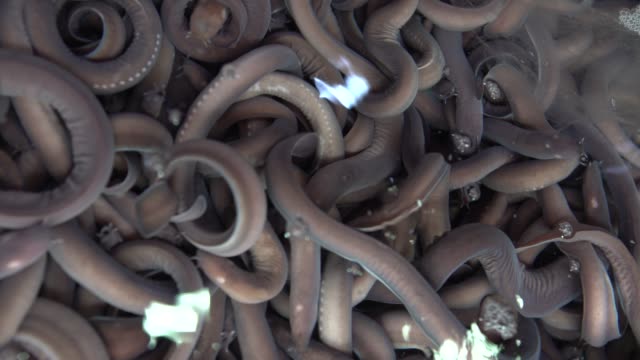How do hagfish produce slime?

There’s a creature with a strange gift living deep in the ocean’s abyss, far from light. The hagfish, widely regarded as the most repulsive animal in the water, has the ability to quickly and readily create large quantities of slime. Not only is this sticky substance interesting, but it is essential to the hagfish’s life. Let’s examine the complex mechanism by which the hagfish makes its slime.
Knowing the Fundamentals of Hagfish
The hagfish is a fascinating creature found in the chilly oceans around the world. This creature, which resembles an eel and has a skull devoid of a spinal column, is quite the sight. Its most notable feature, however, is a mouth with rows of keratin teeth that resemble combs. However, their most intriguing feature is not their remarkable appearance.
The ability to make slime gives hagfish an unmatched survival strategy. This sticky fluid, which is made of proteins, serves as a barrier to keep out would-be predators. Hagfish have plenty of time to squirm away to safety thanks to this peculiar but effective tactic that frequently confuses attackers. As we explore the world of hagfish in greater detail, the science underlying this special mechanism for producing slime will astound you.
Hagfish specifically release this slime from unique glands positioned all over their bodies in response to stress or threat. Supported by years of evolution, this response shows a remarkable adaptation for survival in the harsh depths of the ocean. When we take a closer look at how hagfish make their slime, we find that this mechanism helps them feed as well because food particles get trapped in the sticky substance.
The hagfish is a remarkable marine animal due to the variety and complexity of these survival adaptations. Hagfish exhibit other amazing defensive techniques in addition to producing an unparalleled amount of slime in their struggle for survival. These deep-sea animals are unquestionably proof of the cleverness of evolution, despite their sometimes ill-gotten reputation. Gaining more knowledge about how hagfish make their defense slime could lead to the development of biotechnological applications such as environmentally friendly, water-repellent materials. These inquisitive animals undoubtedly have a great deal more to teach us about creativity and resiliency in the marine environment.
The Role of Slime in the Survival of Hagfish
Hagfish have extremely remarkable survival instincts. Their covert weapon, slime, comes into action when they come across a predator. This is not your ordinary slime, but a super substance that baffles their attacker, buying the hagfish some crucial escape time. The moment a predator attacks, the hagfish swiftly responds by expelling slime that dramatically expands once it touches seawater.
This sudden explosion of slime is like a magic trick gone wrong for the attacker, particularly if they have gills. The slimy mass clogs up their gills, leading to bewilderment and retreat. But it’s not just an incredible defense mechanism against predators. This slime also offers a protective barrier, wrapping the hagfish like a snug coat, shielding it from injuries as it maneuvers through the perilous crevices and sharp rocks of its marine home.
The ingenious use of slime is just one of the ways the hagfish ensures its survival in the often harsh and unforgiving deep sea environment. In addition to slime, hagfish produce a leather-like skin, resistant to deep-sea pressures, enhancing their resilience further. The bizarre mix of sliminess and toughness allows the hagfish to endure where many other creatures could not. In fact, these unique adaptations are the primary reasons hagfish produce has become a hot topic in biomimicry studies.

Scientists believe their extraordinary survival techniques could lead to revolutionary developments in materials science and biomedical research. Harnessing the secrets of the hagfish produce could inspire innovations in manufacturing resilient materials and unlocking advancements in medical fields such as wound healing. Truly, the humble hagfish has a lot to teach us about resilience and survival. By studying hagfish produce, researchers aim to unlock these secrets and apply them to practical human problems. Imagine a world where our materials are as durable and versatile as hagfish skin, or a medical breakthrough inspired by their protective slime.
Composition of the Hagfish Slime
Let’s uncover the secret recipe of the hagfish slime. This awe-inspiring substance, which confounds predators and doubles as a protective barrier, is a result of an ingenious blend. It comprises mucus and fibrous proteins, stored separately in the hagfish’s specialized glands. When these components mix, they change into a sticky, jelly-like substance that immediately expands in seawater.
The truly surprising aspect in this combination, though, is the fibrous proteins. These fibers are unbelievably delicate and yet extremely strong. Imagine a strand 100 times thinner than a human hair but with a strength that outperforms nylon by tenfold. This balance of strength and flexibility generates a substance like no other, serving as the hagfish’s survival secret in the ocean’s depths. We’ve unlocked the enigma of what’s in the slime, but the magic genuinely happens in how it’s generated and distributed. Dive in with us as we explore further. Hagfish manufacture their slime in an amazing method, expelling it with a precise and quick movement.
Let’s explore this incredible process in the next section of our adventure. Watch closely as we watch how the hagfish make their extraordinary slime, shedding light on their hidden key to survival in an underwater universe. Stay tuned to read more about this remarkable and repelling creature’s complex protection mechanism. We’ll look into the remarkable mechanism in which hagfish manufacture and release their famed slime. A story of evolution, necessity, and scientific marvel. Harnessing the enigma of how hagfish make this interesting chemical has not been easy, but scientists continue to push limits in their quest for understanding.
As we learn more about this remarkable biological system, stay tuned. Hagfish’s elaborate dance is a powerful example of how adaptation and survival are handled in the animal kingdom. Prepare to explore the wonders of our marine world on a deeper level.
How the Slime is produced by Hagfish
The hagfish’s specialized slime glands, which are neatly placed along its body, are where the slime-making extravaganza begins. Two types of unique cells are found in these intriguing factories: mucous cells and thread cells. These cells activate and are released through ducts located throughout the hagfish’s body as soon as danger appears.
An amazing metamorphosis takes place as soon as these released cells come into contact with seawater. While the thread cells release proteins that uncoil at an alarming rate, the mucous cells begin to generate mucus. These threads unravel and entwine with the mucous to create the amazing slime known as hagfish. Particularly when you look into the quick uncoiling of the protein threads, the mechanics underlying this process are almost as fascinating as the slime itself. Hagfish make these proteins and turn them into slime very quickly; it only takes a few seconds for them to come together.
This organism is quite a sight in the aquatic world because of its lightning-fast reaction to possible threats. More research on the process by which hagfish make their unique slime could lead to advances in material science. Imagine adhesive wound sealants that stick swiftly to water, or materials that mirror the flexibility of this slime. In fact, researchers are working to figure out how hagfish make this special slime in the hopes of discovering its secrets for a variety of uses. Their research could revolutionize how we think about bioengineering and bring forth a remarkable new age of biomimicry.
Uncoiling the Skeins of Thread
Now let’s explore the most interesting part of this procedure: unwinding thread skeins. The proteins in these thread cells are compactly twisted, resembling a tightly coiled skein of yarn. But then a remarkable thing happens—they come upon a warning sign of peril. They begin to unfold quite quickly, creating long, thin, robust threads.
It is similar to witnessing an extremely rapid rewind of a yarn spool unwinding. The combination of mucus and seawater causes this incredibly quick unraveling, which creates the abundant slime that we have been unwinding. The mechanism underlying this uncoiling process is every bit as remarkable as the slime and plays a major role in the rapid and large-scale production of the hagfish’s protective layer. Hagfish slime wouldn’t work as well without these quickly unraveling thread skeins. So let’s honor these uncoiling thread skeins and their important, silent role in the amazing world of hagfish slime.
The Unprecedented Amount of Slime Made
Ever pondered how much slime a hagfish could possibly make? It’s nothing short of fantastic, to put it briefly. A single hagfish can produce enough slime to fill a five-gallon container in a matter of seconds. By no means is this a trivial accomplishment!
What then is the secret to producing so much slime? The hagfish’s uniquely shaped slime glands and the slime’s remarkable expandable qualities hold the key to the solution. The slime expands almost instantly when it comes into contact with seawater, forming an enormous, gooey shield that is protective.
Envision engaging in a water balloon battle where you had the ability to produce an infinite amount of balloons nearly instantly. Hagfish experience something similar when they are in danger from a predator. Hagfish are an amazing example of nature’s inventiveness in developing survival strategies because of their remarkable ability to produce large quantities of slime quickly when under stress. Thus, the next time you encounter a hagfish, show it some appreciation for its amazing ability to make slime. Not every creature can truly claim to be able to quickly fill a bucket with slime, after all!

Hagfish Slime’s Potential Uses Go Beyond Defense
In addition to being an intriguing means of survival, the sticky defense mechanism of hagfish has a wealth of potential uses outside of the deep sea. Our adventure with hagfish slime gets even more fascinating at this point. Recall the incredibly robust protein strands we previously discussed? Scientists and innovators are taking notice of them, and this is spurring innovations across a range of industries. Imagine materials that are made from a biodegradable, renewable resource and stronger than spider silk.
This might be used by the fashion industry to produce long-lasting, ecological clothing. Consider the advantages of these protein threads’ strength and flexibility for surgical sutures and wound dressings. Now, envision these threads being utilized in the defense sector for bulletproof vests. Sounds like science fiction, doesn’t it? But it’s not. It’s the reality of the potential held within the modest hagfish’s slime. So next time you hear about hagfish slime, think not of the disgusting, but of the revolutionary potential it represents.
This slippery substance is not just a monument to nature’s amazing survival adaptations but might also be a vital player in influencing the future of sustainable materials. Now isn’t there something to respect about the hagfish?



